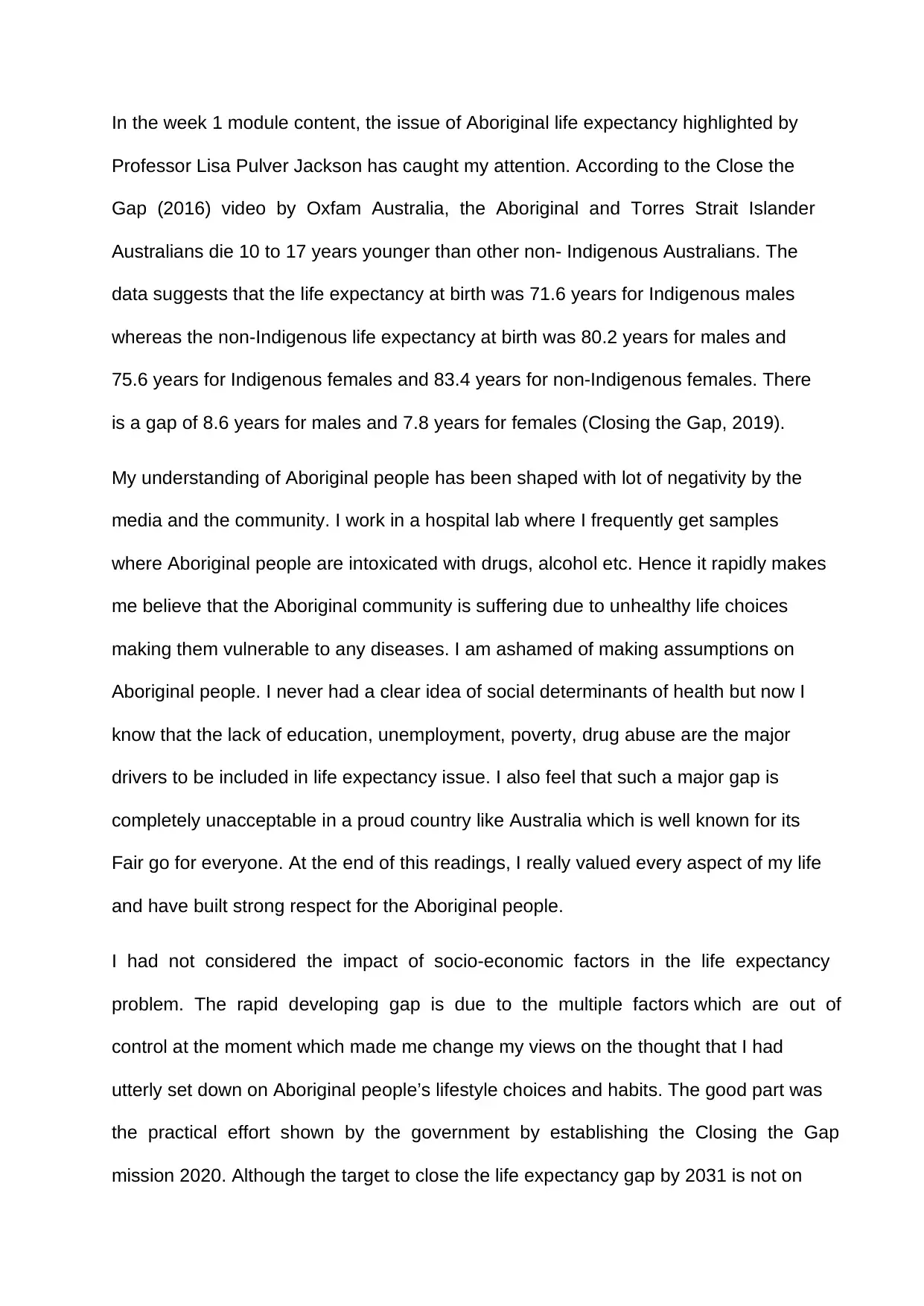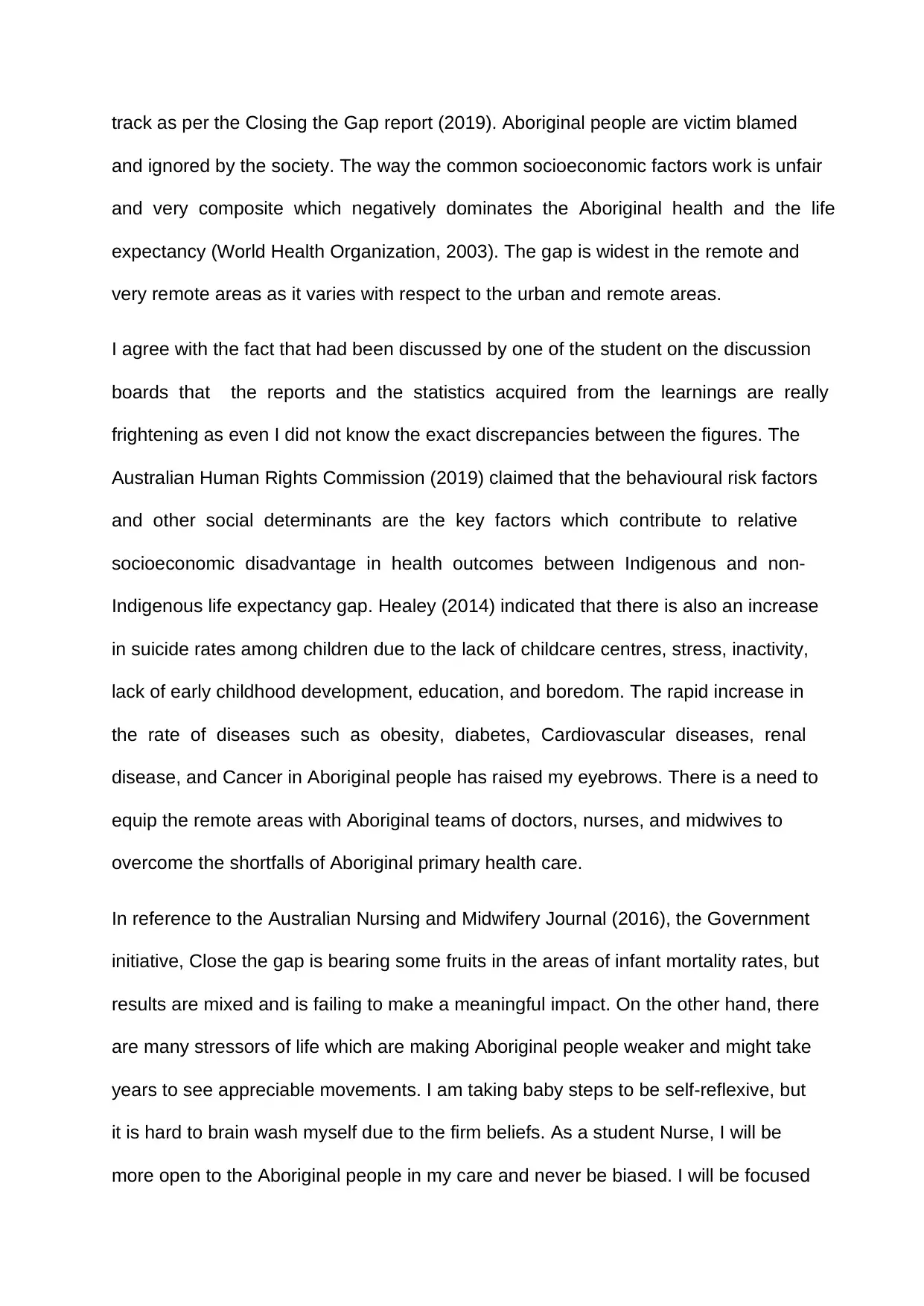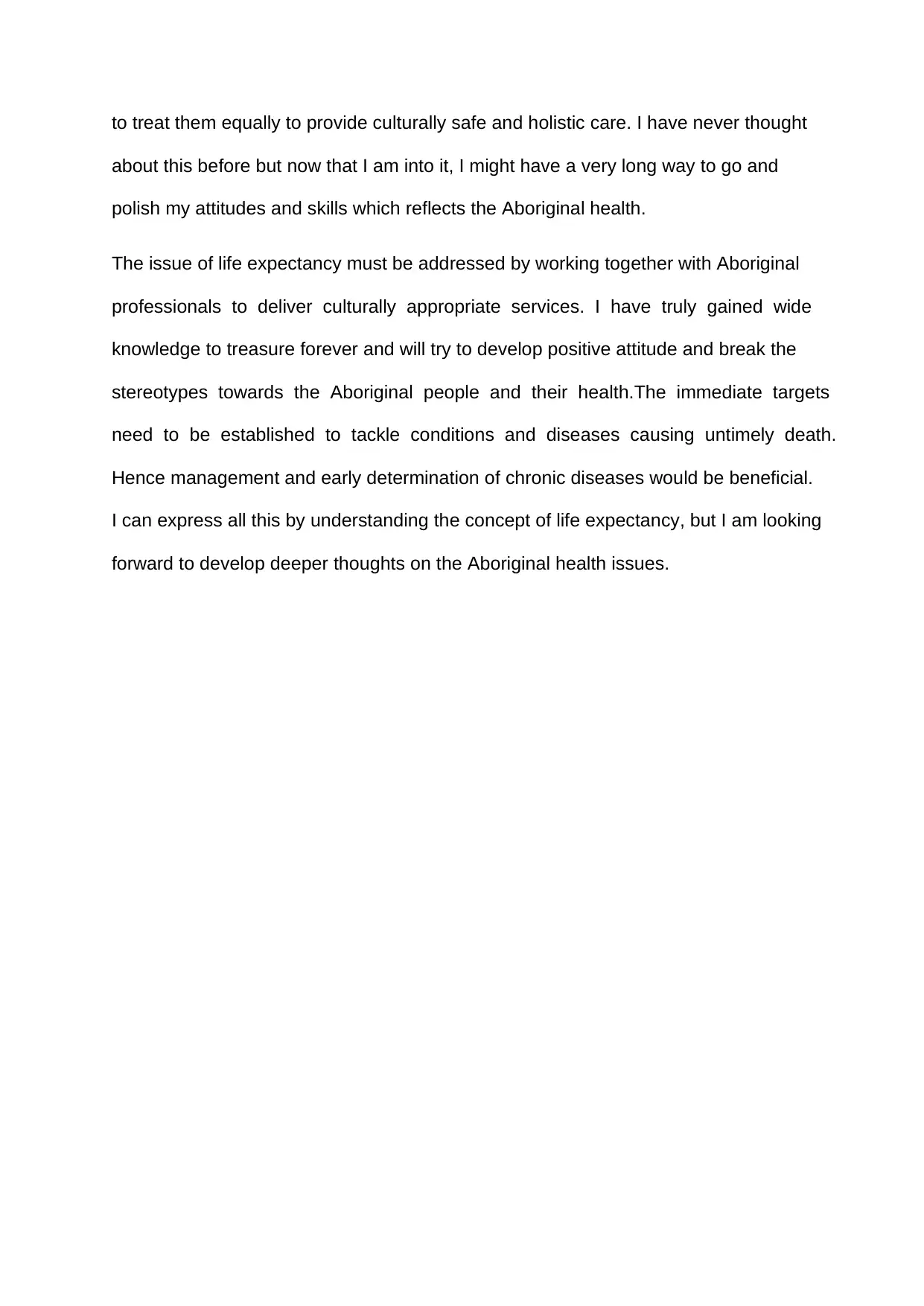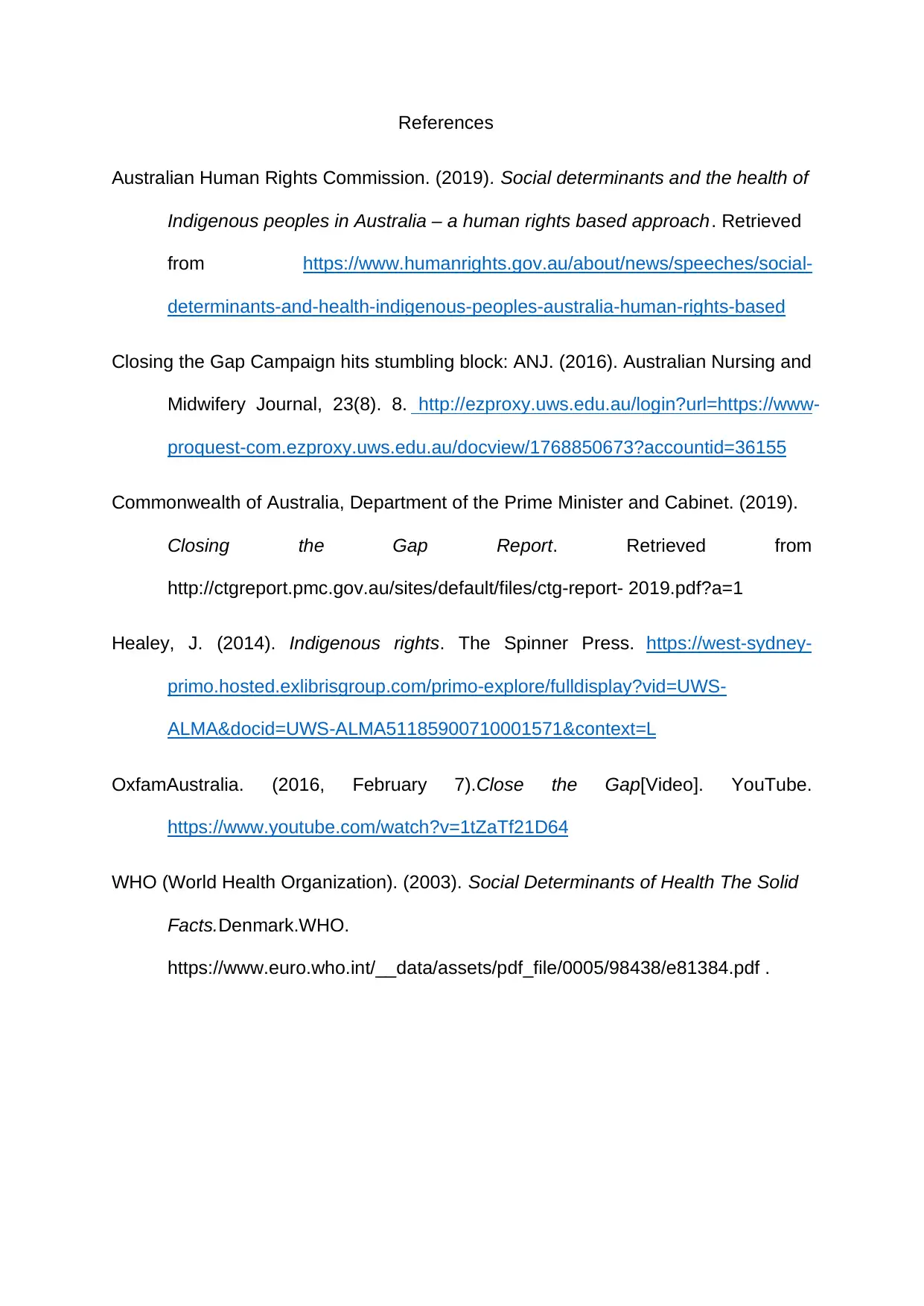Analysis of Aboriginal Life Expectancy and Health Issues
VerifiedAdded on 2021/07/28
|4
|1071
|113
Discussion Board Post
AI Summary
This discussion post reflects on the significant disparity in life expectancy between Aboriginal and non-Indigenous Australians, prompted by the week 1 module content. The author, initially influenced by negative media portrayals, shares a personal transformation after learning about the social d...

In the week 1 module content, the issue of Aboriginal life expectancy highlighted by
Professor Lisa Pulver Jackson has caught my attention. According to the Close the
Gap (2016) video by Oxfam Australia, the Aboriginal and Torres Strait Islander
Australians die 10 to 17 years younger than other non- Indigenous Australians. The
data suggests that the life expectancy at birth was 71.6 years for Indigenous males
whereas the non-Indigenous life expectancy at birth was 80.2 years for males and
75.6 years for Indigenous females and 83.4 years for non-Indigenous females. There
is a gap of 8.6 years for males and 7.8 years for females (Closing the Gap, 2019).
My understanding of Aboriginal people has been shaped with lot of negativity by the
media and the community. I work in a hospital lab where I frequently get samples
where Aboriginal people are intoxicated with drugs, alcohol etc. Hence it rapidly makes
me believe that the Aboriginal community is suffering due to unhealthy life choices
making them vulnerable to any diseases. I am ashamed of making assumptions on
Aboriginal people. I never had a clear idea of social determinants of health but now I
know that the lack of education, unemployment, poverty, drug abuse are the major
drivers to be included in life expectancy issue. I also feel that such a major gap is
completely unacceptable in a proud country like Australia which is well known for its
Fair go for everyone. At the end of this readings, I really valued every aspect of my life
and have built strong respect for the Aboriginal people.
I had not considered the impact of socio-economic factors in the life expectancy
problem. The rapid developing gap is due to the multiple factors which are out of
control at the moment which made me change my views on the thought that I had
utterly set down on Aboriginal people’s lifestyle choices and habits. The good part was
the practical effort shown by the government by establishing the Closing the Gap
mission 2020. Although the target to close the life expectancy gap by 2031 is not on
Professor Lisa Pulver Jackson has caught my attention. According to the Close the
Gap (2016) video by Oxfam Australia, the Aboriginal and Torres Strait Islander
Australians die 10 to 17 years younger than other non- Indigenous Australians. The
data suggests that the life expectancy at birth was 71.6 years for Indigenous males
whereas the non-Indigenous life expectancy at birth was 80.2 years for males and
75.6 years for Indigenous females and 83.4 years for non-Indigenous females. There
is a gap of 8.6 years for males and 7.8 years for females (Closing the Gap, 2019).
My understanding of Aboriginal people has been shaped with lot of negativity by the
media and the community. I work in a hospital lab where I frequently get samples
where Aboriginal people are intoxicated with drugs, alcohol etc. Hence it rapidly makes
me believe that the Aboriginal community is suffering due to unhealthy life choices
making them vulnerable to any diseases. I am ashamed of making assumptions on
Aboriginal people. I never had a clear idea of social determinants of health but now I
know that the lack of education, unemployment, poverty, drug abuse are the major
drivers to be included in life expectancy issue. I also feel that such a major gap is
completely unacceptable in a proud country like Australia which is well known for its
Fair go for everyone. At the end of this readings, I really valued every aspect of my life
and have built strong respect for the Aboriginal people.
I had not considered the impact of socio-economic factors in the life expectancy
problem. The rapid developing gap is due to the multiple factors which are out of
control at the moment which made me change my views on the thought that I had
utterly set down on Aboriginal people’s lifestyle choices and habits. The good part was
the practical effort shown by the government by establishing the Closing the Gap
mission 2020. Although the target to close the life expectancy gap by 2031 is not on
Paraphrase This Document
Need a fresh take? Get an instant paraphrase of this document with our AI Paraphraser

track as per the Closing the Gap report (2019). Aboriginal people are victim blamed
and ignored by the society. The way the common socioeconomic factors work is unfair
and very composite which negatively dominates the Aboriginal health and the life
expectancy (World Health Organization, 2003). The gap is widest in the remote and
very remote areas as it varies with respect to the urban and remote areas.
I agree with the fact that had been discussed by one of the student on the discussion
boards that the reports and the statistics acquired from the learnings are really
frightening as even I did not know the exact discrepancies between the figures. The
Australian Human Rights Commission (2019) claimed that the behavioural risk factors
and other social determinants are the key factors which contribute to relative
socioeconomic disadvantage in health outcomes between Indigenous and non-
Indigenous life expectancy gap. Healey (2014) indicated that there is also an increase
in suicide rates among children due to the lack of childcare centres, stress, inactivity,
lack of early childhood development, education, and boredom. The rapid increase in
the rate of diseases such as obesity, diabetes, Cardiovascular diseases, renal
disease, and Cancer in Aboriginal people has raised my eyebrows. There is a need to
equip the remote areas with Aboriginal teams of doctors, nurses, and midwives to
overcome the shortfalls of Aboriginal primary health care.
In reference to the Australian Nursing and Midwifery Journal (2016), the Government
initiative, Close the gap is bearing some fruits in the areas of infant mortality rates, but
results are mixed and is failing to make a meaningful impact. On the other hand, there
are many stressors of life which are making Aboriginal people weaker and might take
years to see appreciable movements. I am taking baby steps to be self-reflexive, but
it is hard to brain wash myself due to the firm beliefs. As a student Nurse, I will be
more open to the Aboriginal people in my care and never be biased. I will be focused
and ignored by the society. The way the common socioeconomic factors work is unfair
and very composite which negatively dominates the Aboriginal health and the life
expectancy (World Health Organization, 2003). The gap is widest in the remote and
very remote areas as it varies with respect to the urban and remote areas.
I agree with the fact that had been discussed by one of the student on the discussion
boards that the reports and the statistics acquired from the learnings are really
frightening as even I did not know the exact discrepancies between the figures. The
Australian Human Rights Commission (2019) claimed that the behavioural risk factors
and other social determinants are the key factors which contribute to relative
socioeconomic disadvantage in health outcomes between Indigenous and non-
Indigenous life expectancy gap. Healey (2014) indicated that there is also an increase
in suicide rates among children due to the lack of childcare centres, stress, inactivity,
lack of early childhood development, education, and boredom. The rapid increase in
the rate of diseases such as obesity, diabetes, Cardiovascular diseases, renal
disease, and Cancer in Aboriginal people has raised my eyebrows. There is a need to
equip the remote areas with Aboriginal teams of doctors, nurses, and midwives to
overcome the shortfalls of Aboriginal primary health care.
In reference to the Australian Nursing and Midwifery Journal (2016), the Government
initiative, Close the gap is bearing some fruits in the areas of infant mortality rates, but
results are mixed and is failing to make a meaningful impact. On the other hand, there
are many stressors of life which are making Aboriginal people weaker and might take
years to see appreciable movements. I am taking baby steps to be self-reflexive, but
it is hard to brain wash myself due to the firm beliefs. As a student Nurse, I will be
more open to the Aboriginal people in my care and never be biased. I will be focused

to treat them equally to provide culturally safe and holistic care. I have never thought
about this before but now that I am into it, I might have a very long way to go and
polish my attitudes and skills which reflects the Aboriginal health.
The issue of life expectancy must be addressed by working together with Aboriginal
professionals to deliver culturally appropriate services. I have truly gained wide
knowledge to treasure forever and will try to develop positive attitude and break the
stereotypes towards the Aboriginal people and their health.The immediate targets
need to be established to tackle conditions and diseases causing untimely death.
Hence management and early determination of chronic diseases would be beneficial.
I can express all this by understanding the concept of life expectancy, but I am looking
forward to develop deeper thoughts on the Aboriginal health issues.
about this before but now that I am into it, I might have a very long way to go and
polish my attitudes and skills which reflects the Aboriginal health.
The issue of life expectancy must be addressed by working together with Aboriginal
professionals to deliver culturally appropriate services. I have truly gained wide
knowledge to treasure forever and will try to develop positive attitude and break the
stereotypes towards the Aboriginal people and their health.The immediate targets
need to be established to tackle conditions and diseases causing untimely death.
Hence management and early determination of chronic diseases would be beneficial.
I can express all this by understanding the concept of life expectancy, but I am looking
forward to develop deeper thoughts on the Aboriginal health issues.
You're viewing a preview
Unlock full access by subscribing today!

References
Australian Human Rights Commission. (2019). Social determinants and the health of
Indigenous peoples in Australia – a human rights based approach. Retrieved
from https://www.humanrights.gov.au/about/news/speeches/social-
determinants-and-health-indigenous-peoples-australia-human-rights-based
Closing the Gap Campaign hits stumbling block: ANJ. (2016). Australian Nursing and
Midwifery Journal, 23(8). 8. http://ezproxy.uws.edu.au/login?url=https://www-
proquest-com.ezproxy.uws.edu.au/docview/1768850673?accountid=36155
Commonwealth of Australia, Department of the Prime Minister and Cabinet. (2019).
Closing the Gap Report. Retrieved from
http://ctgreport.pmc.gov.au/sites/default/files/ctg-report- 2019.pdf?a=1
Healey, J. (2014). Indigenous rights. The Spinner Press. https://west-sydney-
primo.hosted.exlibrisgroup.com/primo-explore/fulldisplay?vid=UWS-
ALMA&docid=UWS-ALMA51185900710001571&context=L
OxfamAustralia. (2016, February 7).Close the Gap[Video]. YouTube.
https://www.youtube.com/watch?v=1tZaTf21D64
WHO (World Health Organization). (2003). Social Determinants of Health The Solid
Facts.Denmark.WHO.
https://www.euro.who.int/__data/assets/pdf_file/0005/98438/e81384.pdf .
Australian Human Rights Commission. (2019). Social determinants and the health of
Indigenous peoples in Australia – a human rights based approach. Retrieved
from https://www.humanrights.gov.au/about/news/speeches/social-
determinants-and-health-indigenous-peoples-australia-human-rights-based
Closing the Gap Campaign hits stumbling block: ANJ. (2016). Australian Nursing and
Midwifery Journal, 23(8). 8. http://ezproxy.uws.edu.au/login?url=https://www-
proquest-com.ezproxy.uws.edu.au/docview/1768850673?accountid=36155
Commonwealth of Australia, Department of the Prime Minister and Cabinet. (2019).
Closing the Gap Report. Retrieved from
http://ctgreport.pmc.gov.au/sites/default/files/ctg-report- 2019.pdf?a=1
Healey, J. (2014). Indigenous rights. The Spinner Press. https://west-sydney-
primo.hosted.exlibrisgroup.com/primo-explore/fulldisplay?vid=UWS-
ALMA&docid=UWS-ALMA51185900710001571&context=L
OxfamAustralia. (2016, February 7).Close the Gap[Video]. YouTube.
https://www.youtube.com/watch?v=1tZaTf21D64
WHO (World Health Organization). (2003). Social Determinants of Health The Solid
Facts.Denmark.WHO.
https://www.euro.who.int/__data/assets/pdf_file/0005/98438/e81384.pdf .
1 out of 4
Related Documents
Your All-in-One AI-Powered Toolkit for Academic Success.
+13062052269
info@desklib.com
Available 24*7 on WhatsApp / Email
![[object Object]](/_next/static/media/star-bottom.7253800d.svg)
Unlock your academic potential
© 2024 | Zucol Services PVT LTD | All rights reserved.





